
The Residential Air Purifier Market In China Is Projected To Grow By USD 312.2 Million (2024-2028), Driven By Product Innovation And AI's Impact On Market Trends - Technavio
| Forecast period |
2024-2028 |
| Base Year |
2023 |
| Historic Data |
2017 - 2021 |
| Segment Covered |
Technology (HEPA and ULPA air purifiers, Ionizers and electrostatic precipitator air purifiers, Activated carbon air purifiers, Photocatalyst and UV air purifiers, and Ozone generator air purifiers), Distribution Channel (Offline and Online), and Geography (APAC) |
| Region Covered |
China |
| Key companies profiled |
3M Co., China Lesso Group Holdings Ltd., Coway Co. Ltd., Cubic Sensor and Instrument Co. Ltd., Dyson Group Co., Guangzhou Haike Electronics Technology Co. Ltd., IQAir AG, Koninklijke Philips N.V., LG Electronics Inc., MIDEA Group Co. Ltd., Oransi LLC, Panasonic Holdings Corp., Richform Holdings Ltd., Samsung Electronics Co. Ltd., Sharp Corp., Smart Air, Suzhou HJClEAN Tech Co. Ltd., Unilever PLC, Whirlpool Corp., and Xiaomi Communications Co. Ltd. |
Key Market Trends Fueling Growth
The residential air purifier market in China is experiencing significant growth due to increasing consumer awareness and demand for advanced air purification solutions. Vendors are capitalizing on this trend by introducing smart air purifiers , which offer user-friendly features and innovative technologies. These smart air purifiers come with Energy Star certification for energy efficiency, hassle-free maintenance, alert systems for fault detection, enhanced safety features, and remote control capabilities. The Wi-Fi-enabled Honeywell Air Touch X3 Office Air Purifier is an example of such a product, offering users the convenience of controlling the device and monitoring air quality through a mobile application. These features are expected to drive the growth of the residential air purifier market in China during the forecast period.
The Residential Air Purifier market in China is witnessing significant growth due to rising concerns over airborne diseases and indoor air pollution. Contaminated air causes premature deaths and respiratory diseases, making healthy lifestyle choices essential. HEPA technology, UV irradiation, and activated carbon filters are popular solutions for removing airborne particles and Volatile Organic Compounds. Air quality regulations are driving demand for advanced technologies like photocatalytic oxidation and ozonation. Smog and combustion sources like oil, gas , kerosene, coal, wood, tobacco, asbestos-containing insulation, and pressed wood products contribute to indoor pollution. Smart homes and energy-efficient air purifiers are trends, with portable/standalone purifiers and in-duct air purifiers catering to various needs. Nephelometers, gas sensors, and PCR-based biosensors aid in monitoring air quality. Outdoor pollutants like radon, pesticides, and Carbon Monoxide also impact air quality, necessitating comprehensive air purification solutions. Government interventions and air quality policies are shaping the market landscape.
Insights on how AI is driving innovation, efficiency, and market growth- Request Sample!
Market
Challenges
-
Residential air purifiers have gained popularity among Chinese consumers due to increasing air pollution concerns. However, the high maintenance cost, particularly for replacing air filters every four to six months, poses a significant challenge. HEPA filters, essential for effective filtration, can be expensive to replace. Premium air purifiers with longer-lasting filters are costlier, making affordability a concern. Vendors must address this issue to expand the market. Consumers seek cost-effective air purifiers that improve indoor air quality without excessive maintenance costs. The high replacement cost for air filters may deter potential buyers, potentially hindering the growth of the residential air purifier market in China.
The Residential Air Purifier market in China faces several challenges. Indoor pollutants such as combustion sources like oil, gas, kerosene, coal, wood, tobacco, and asbestos-containing insulation, pressed wood products, and household cleaning products contribute to poor indoor air quality. Outdoor pollutants, including radon, pesticides, carbon monoxide, nitrogen dioxide, and pollutants like volatile organic compounds and harmful chemical vapors, also pose a threat. Public awareness of health issues like asthma, COPD, lung cancer, and the impact of greenhouse gases on air quality is growing. The market consists of portable/standalone air purifiers and ionizers. Big data analytics and IoT platforms are being used to improve air quality monitoring and control. Airborne microbes like Bacillus subtilis, Aspergillus Niger, Staphylococcus epidermidis, and Penicillium citrinum are common pollutants. Providing clean air is essential for maintaining good health.
Insights into how AI is reshaping industries and driving growth-
Download a Sample Report
Segment Overview
This residential air purifier market in China report extensively covers market segmentation by
Technology-
1.1 HEPA and ULPA air purifiers
1.2 Ionizers and electrostatic precipitator air purifiers
1.3 Activated carbon air purifiers
1.4 Photocatalyst and UV air purifiers
1.5 Ozone generator air purifiers
-
2.1 Offline
2.2 Online
-
3.1 APAC
1.1
HEPA and ULPA air purifiers-
HEPA filters, a type of mechanical air filter, are widely used in residential air purifiers due to their high filtration efficiency. These filters work by trapping harmful particles such as pollen, pet dander, dust mites, and tobacco smoke, using interception, impaction, and diffusion mechanisms. HEPA filters are effective in removing PM (particulate matter) and formaldehyde from the air, with filtration efficiencies reaching up to 99.97%. Consumers prefer installing air purifiers in rooms where they spend most of their time, especially in the bedroom. Air purifiers with HEPA filters are readily available in specialty stores, home improvement stores, and department stores. ULPA filters, also known as ultra-HEPA, capture 99.999% of harmful airborne particles that are 0.12 Mu m or larger in diameter. These filters have a short lifespan and require replacement every three to six months. The growth of the HEPA and ULPA air purifiers technology segment is expected to propel the residential air purifier market in China due to their high filtration efficiency and increasing adoption rate.
Download complimentary Sample Report to gain insights into AI's impact on market dynamics, emerging trends, and future opportunities- including forecast (2024-2028) and historic data (2017 - 2021)
Research Analysis
The Residential Air Purifier market in China has witnessed significant growth due to increasing concerns over airborne diseases and indoor air pollution. Contaminated air, caused by industrial emissions and vehicle exhaust, can lead to premature deaths and respiratory diseases such as asthma, COPD, and lung cancer. HEPA technology, Nephelometers, gas sensors , and PCR-based biosensors are essential components of air purifiers, filtering airborne particles and gases. Energy-efficient air purifiers, smart homes, and IoT platforms are trending, offering convenience and real-time air quality monitoring. Air quality regulations are driving market growth, with a focus on reducing emissions and improving overall air quality. Ionic filters, UV filters, and ionizers are other popular technologies used in air purifiers to combat indoor pollutants. Portable/standalone purifiers and big data analytics provide customized solutions for individual needs.
Market Research Overview
The Residential Air Purifier market in China has witnessed significant growth due to increasing health consciousness and rising concerns over airborne diseases caused by indoor air pollution. Contaminated air, which contains airborne particles, Volatile Organic Compounds (VOCs), and harmful chemical vapors, can lead to respiratory diseases such as asthma, COPD, and even lung cancer. Indoor sources of pollution include combustion sources like oil, gas, kerosene, coal, wood, and tobacco, as well as asbestos-containing insulation, pressed wood products, and household cleaning products. Outdoor pollutants such as smog, radon, pesticides, carbon monoxide, and nitrogen dioxide also contribute to indoor air pollution. HEPA technology, HEPA filters, UV filters, ionic filters, and other advanced air purification technologies like photocatalytic oxidation, ozonation, and electrostatic precipitators are being widely adopted to combat indoor air pollution. The market includes both portable/standalone purifiers and in-duct air purifiers. Government interventions and air quality policies, such as the implementation of air quality regulations and public awareness campaigns, are driving the market's growth. Smart homes, energy-efficient air purifiers, and advanced technologies like nephelometers, gas sensors, and PCR-based biosensors are also gaining popularity. Airborne microbes such as Bacillus subtilis, Aspergillus Niger, Staphylococcus epidermidis, and Penicillium citrinum are significant contributors to indoor air pollution and can lead to various health issues. The market for residential air purifiers in China is expected to continue growing as people prioritize clean air for a healthy lifestyle.
Table of Contents:
1 Executive Summary
2 Market Landscape
3 Market Sizing
4 Historic Market Size
5 Five Forces Analysis
6 Market Segmentation
-
Technology
-
HEPA And ULPA Air Purifiers
Ionizers And Electrostatic Precipitator Air Purifiers
Activated Carbon Air Purifiers
Photocatalyst And UV Air Purifiers
Ozone Generator Air Purifiers
-
Offline
Online
-
APAC
7 Customer Landscape
8 Geographic Landscape
9 Drivers, Challenges, and Trends
10 Company Landscape
11 Company Analysis
12 Appendix
About Technavio
Technavio is a leading global technology research and advisory company. Their research and analysis focuses on emerging market trends and provides actionable insights to help businesses identify market opportunities and develop effective strategies to optimize their market positions.
With over 500 specialized analysts, Technavio's report library consists of more than 17,000 reports and counting, covering 800 technologies, spanning across 50 countries. Their client base consists of enterprises of all sizes, including more than 100 Fortune 500 companies. This growing client base relies on Technavio's comprehensive coverage, extensive research, and actionable market insights to identify opportunities in existing and potential markets and assess their competitive positions within changing market scenarios.
Contacts
Technavio Research
Jesse Maida
Media & Marketing Executive
US: +1 844 364 1100
UK: +44 203 893 3200
Email:
[email protected]
Website:
SOURCE Technavio
WANT YOUR COMPANY'S NEWS FEATURED ON PRNEWSWIRE? 440k+Newsrooms &
Influencers 9k+
Digital Media
Outlets 270k+
Journalists
Opted In GET STARTED

Legal Disclaimer:
MENAFN provides the
information “as is” without warranty of any kind. We do not accept
any responsibility or liability for the accuracy, content, images,
videos, licenses, completeness, legality, or reliability of the information
contained in this article. If you have any complaints or copyright
issues related to this article, kindly contact the provider above.



















Comments
No comment